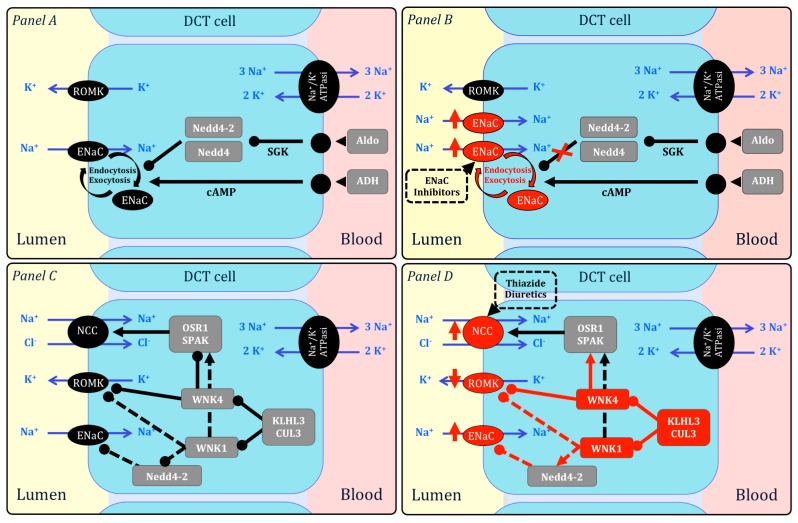Figure 1.
Gordon and Liddle syndromes. Panel A—Epithelial Na+ Channel (ENaC) is expressed in the distal convoluted tubule (DCT) at the apical membrane, where it allows Na+ in the lumen to enter the cell. At the baso-lateral membrane, Na+ is pumped outwards by Na+-K+ ATPase. ENaC membrane expression is regulated through membrane trafficking. Aldosterone (Aldo), vasopressin (ADH), Nedd4 and Nedd4-2 regulate membrane endocytosis and exocytosis, through cAMP-dependent pathways and aldosterone/serum and glucocorticoid-regulated kinase (SGK). Panel B—ENaC gain-of-function mutations determine resistance to Nedd-mediated ubiquitination with ENaC over-expression. ENaC inhibitors (such as amiloride) block ENaC and normalize BP. Panel C—Na+-Cl− co-transporter (NCC), potassium channel (ROMK) and ENaC are responsible for Na+ and K+ homeostasis in DCT. Different intracellular factors regulate the activity of these transporters: WNK1 and WNK4 (kinases which inhibit NCC and ROMK), KLHL3 and CUL3 (ubiquitin ligases which mediate WNK kinases degradation). Panel D—The net effect of gain-of-functions mutations in WNK1 and loss-of-function mutations in WNK4, KLHL3 and CUL3 is the excessive activation of NCC and ENaC and the inhibition of ROMK, with increased reabsorption of sodium and reduced excretion of potassium. Thiazide diuretics block NCC and normalize BP. Arrows indicate up-regulation whereas lines ending in closed circles indicate down-regulation. Fine lines indicate established pathways, whereas dotted lines indicate pathways observed in in vitro models. The effects of mutations are indicated in red. Modified from Pathare 2013 [27] and Snyder 2002 [29].

